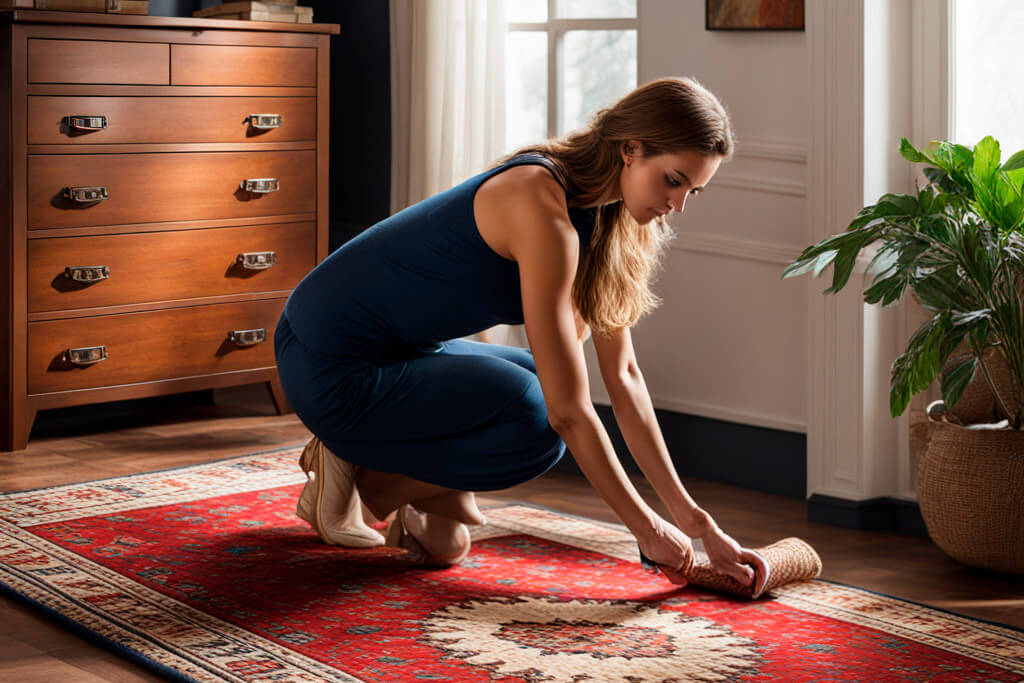Tackling wool rug maintenance is akin to preparing for a significant renovation project. It’s about understanding the value and the characteristics of what you’re working with, and then applying the right techniques to maintain or enhance its condition.
- Importance in Home Improvement: A well-maintained wool rug can transform a room much like a fresh coat of paint or a newly polished floor. It’s not just about cleanliness, it’s about preserving and enhancing the overall feel and design of your living space.
- Why Special Care?: Wool rugs, with their unique qualities, require a specific approach. Just as you would carefully select the right varnish for a piece of antique furniture, choosing the correct method for cleaning a wool rug is essential for its longevity and appearance.

Understanding Wool Rugs
In the realm of rug materials, wool stands out for its durability and aesthetic appeal, much like hardwood does in the world of construction materials.
- Natural and Durable: Wool is resilient, able to withstand heavy foot traffic and everyday wear and tear, much like a well-constructed hardwood floor.
- Hides Dirt Well: Wool’s ability to hide soil and dust is remarkable, but this also means that by the time a rug looks dirty, it’s likely harboring a significant amount of grime.
- Aesthetic and Comfort Role: A wool rug adds a layer of warmth and comfort to any space, enhancing the room’s ambiance in the same way that well-crafted woodwork or stonework can.
Pre-Cleaning Considerations
Before you begin, it’s essential to assess and understand the type of wool rug you’re dealing with:
- Type of Wool Rug: Determine whether your rug is handmade or machine-made, as this will influence the cleaning method you choose.
- Manufacturer’s Care Instructions: Always refer to the manufacturer’s guidelines. This is akin to consulting the building codes and regulations before starting a renovation project.
- Importance of Regular Vacuuming: Regular vacuuming is to a wool rug what routine maintenance is to a building. It prevents the accumulation of dirt and grime that can wear down the rug over time.

Basic Cleaning Methods
Effective wool rug cleaning is about using the right tools and techniques:
- Vacuuming Techniques:
- Opt for a vacuum with adjustable suction settings. High suction can be too aggressive, similar to using a power sander when a hand sanding would suffice.
- Avoid vacuums with beater bars, as they can damage the delicate fibers of the rug, much like how a too-powerful drill can strip a screw.
- Avoiding Damage:
- Avoid high heat and harsh chemicals. These can degrade the wool fibers, similar to how inappropriate cleaning agents can damage wood finishes.
- Use wool-safe detergents and cool water. This is like choosing the right sealant for a particular type of wood, ensuring it enhances rather than damages the material.
By following these guidelines, you can ensure that your wool rug remains a beautiful and integral part of your home for years to come, much like any well-executed renovation project.
Spot Cleaning Wool Rugs
Spot cleaning a wool rug is akin to addressing a small but noticeable issue in a renovation project. It requires precision, the right tools, and a bit of know-how.
- Identify the Stain: First, figure out what you’re dealing with. Is it a coffee spill or maybe a pet accident? Each type of stain has its nuances, similar to different types of wood requiring specific treatments.
- Blotting Technique: Use a clean, absorbent cloth to blot the stain. The key here is to absorb, not rub, which can spread the stain or damage the rug’s fibers. It’s similar to gently removing excess caulk without smearing it.
- Choose Your Cleaner: A mild detergent solution works for most stains, like a versatile joint compound suitable for various applications. Alternatively, a mixture of white vinegar and water can be used, particularly effective for pet odors and lighter stains.
- Application: Apply the cleaner gently with a soft brush or sponge. Imagine you’re applying a fine finish to a delicate wood surface – it requires a soft touch.
- Rinse and Dry: After cleaning, rinse the area with cold water and blot dry. Ensuring all cleaning solution is removed is crucial, akin to cleaning up all residue after sanding a piece of wood.

Deep Cleaning Wool Rugs
Deep cleaning a wool rug is like undertaking a significant renovation project. It demands more extensive effort but is vital for long-term maintenance.
- Knowing When to Deep Clean: It’s essential to recognize when your rug needs a deep clean. Signs include general dullness or an accumulation of dirt and grime, similar to noticing wear and tear on a frequently used piece of furniture.
- DIY or Professional Help: Decide whether to clean the rug yourself or hire professionals. DIY is cost-effective but time-consuming, much like undertaking a home renovation project on your own. Professional cleaners, on the other hand, offer expertise and efficiency.
- DIY Deep Cleaning: If you choose the DIY route, you can rent a carpet cleaner designed for wool rugs. Follow the instructions carefully, as you would when using a new power tool for a delicate job.
Drying and Post-Cleaning Care
The final step, drying and post-cleaning care, is crucial for preserving the rug’s integrity and appearance.
- Drying Method: Dry your rug away from direct sunlight and heat sources. This prevents damage such as shrinking or fading, akin to protecting freshly painted surfaces from direct sunlight.
- Restoring the Pile: Once the rug is dry, use a soft-bristle brush to gently lift the pile. This step is comparable to the final sanding and finishing touches in a woodworking project, essential for achieving the desired outcome.
Preventive Measures and Regular Maintenance
In my years of renovation, I’ve learned that consistent maintenance is key, just as it is with wool rugs. It’s like keeping your tools sharp and your worksite orderly – it saves time and trouble in the long run.
- Strategic Rug Placement: Think of your rug as a delicate piece of woodwork. Place it in areas where it’s less likely to be trampled on, similar to how you’d protect a fine finish from heavy wear.
- Shoe-Free Policy: Enforcing a no-shoe policy is like putting down drop cloths before painting. It’s a simple step that prevents major cleaning jobs later.
- Routine Vacuuming: Regular vacuuming is the equivalent of daily cleanup on a job site. It keeps the rug in top shape and prevents the build-up of grime and dirt, which, over time, can be as damaging as neglecting regular maintenance on a building.
Troubleshooting Common Wool Rug Issues
Over the years, I’ve seen my fair share of construction challenges, and dealing with wool rug issues isn’t much different. Here’s how you tackle them:
- Shedding: It’s normal for new rugs to shed a bit, like a newly built house settling. However, if it continues, it might be a sign of lower quality, much like materials that don’t hold up over time in a build.
- Fading: Protect your rug from prolonged sun exposure. It’s akin to using UV protection on woodwork to prevent it from fading and deteriorating.
- Wear and Tear: Regularly rotate your rug to distribute wear evenly. It’s like rotating tasks on a construction site to ensure balanced workload and wear on tools.
- Seeking Professional Help: When damage is beyond a simple fix, consult a professional. It’s similar to calling in a specialized contractor for complex electrical or plumbing issues.
FAQ Section
Steam cleaning can be risky for wool rugs. The intense heat can damage the fibers, similar to how high heat can warp or crack fine wood finishes. Instead, opt for gentler cleaning methods.
A good rule of thumb is to deep clean your wool rug every 12 to 18 months. Think of it as akin to repainting or resealing a deck – necessary periodically to maintain its condition.
Act fast, like you would with a water leak. Blot the rug with towels and let it air dry. Avoid direct heat, which can cause shrinkage, much like how wood can warp when dried too quickly.
Yes, use a soft-bristle attachment. It’s gentle on the rug fibers, similar to using a soft sanding sponge on delicate wood surfaces.
